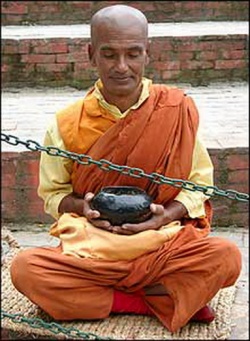Paragraph on Hemis Festival
According to the Tibetan calendar, the great annual festivals held in the villages of Ladakh takes place in winter, with the exception of thseshu held at Hemis in Summer. This is the grand event of the valley, its main feature being the presentation of a mask dance-drama for two days at a stretch. From the time of Rgyalsras Rinpoche around the year 1730, the Hemis Festival has been observed year after year without break and has now become well known world over.
Outgide Sikkim, there is a version of his origin. It. says that he was responsible for introducing the old “Bon” religion with its worship of the devil and sensual delights. He is said to have encouraged his followers to eat meat and drink wine as only after material appetites had been apeased could a state of absolute abstraction be achieved.
According to the records in Sikkim, Padmasambhava came northward and convinced the Lamas of Tibet that he was sent to Tibet as an incarnation of Buddha. It is believed that he descends as a representative incarnate of all the Buddhas, to bestow grace and improve the conditions of living.
He does so on the 10th day of each month and all of the 10th dates which come in a year or the most important of the 10th of the Monkey year in a cycle where the thanka of the guru is exhibited. Each year, The Hemis Festival is observed with sacred performance and dances to bestow good health, subjugate disease and conquer evil spirits.
The most lavish and spectacular of all the festivities is the Mystery play at Hemis, famous for its grotesque and elaborate costumes. The Tibetan call it “Drugpa Tsechu”, which means it takes place on the tenth day of the sixth month of the Ladakh calendar.
The Hemis Festival commemorates the birth day of Guru Padmasambhava, the celebrated founder of the Lama tradition and the presiding authority of Tibetan Buddhism (Red Cap sect). The festival both eulogises the great deeds of Padmasambhava and reiterates the victory over evil for the protection of Buddha dharma.
The Mask dances of Ladakh are referred collectively as ‘Chams’ performance is primarily a part of Tantric tradition, performed only in those gompas which follow, the Tantric vajrayana teachings and the monks perform tantric worship. These dances are performed with masks, and costumes of various meditative and protective deities. Each monk assumes the personage and personality of the deity he is meant to characterize.
The show gains momentum with Tsamchot dance (Dance of the Black Hat Janaka Dancers) followed by Dance of the Sixteen Serbak/ Zangbak Compassionate Dakinis; Dance Honouring the Eight Aspects of Padmasambhava; the Dance of the Protectors of Dharma; Dance of Turdag: Masters of the Graveyard; Dance of the Four Protectors of Dharma; Dance of the Herukas; Dance of Tsoglen Na, who Puts an End to Evil; Worship of Rgyalpo Pehar.
The Protector Deity (The Protectress of Hemis Monastery) and the Dance of Maha Dongchen. The Bison/Buffalow Masked Deity. The dance interpret some significant values that enshrine monastic life. The inner meaning of the horrific, leering, and ghoulish masks is that at death they will reappear again. The person will not be afraid of then seem these dances year after year, one understands the nature of life and the meaning of death.
